Biography
Raden Kosasih was born in Bogor, Indonesia, at April 4, 1919. At the start of his career, he worked as a book illustrator. [1]
Kosasih published his first comics, a five-part comic book series featuring the female superheroes Sri Asih and Siti Gahara, in 1954. It was the first popular indigenous comic book in Indonesia. [2]
Kosasih started from the wayang (Indonesian puppet theatre) stories, traditions and techniques and applied these to comics. His major works were his adaptations of the ancient Indian epics Mahabharata between 1957 and 1959 (the main series in 37 volumes, and many other comics about characters from the epic) and the Ramayana . Other comics by Kosasih include Wayang Purwa and Sri Kresna (four volumes, 1983). [2] His Mahabharata diverged from the typical wayang Indonesian elements in the stories and turned back to the original Indian versions. Its popularity lead to a renewed interest in the wayang versions as well, and many wayang puppeteers incorporated elements from the comics into their stories. [3] [1]
Kosasih continued to write and draw comics until 1993, when Parkinson's disease made it impossible to continue. [1] At the time of his death in 2012 he lived in Ciputat. [4]

The Mahābhārata is one of the two major Smriti texts and Sanskrit epics of ancient India revered in Hinduism, the other being the Rāmāyaṇa. It narrates the events and aftermath of the Kurukshetra War, a war of succession between two groups of princely cousins, the Kauravas and the Pāṇḍavas.

The Ramayana also known as Valmiki Ramayana, as traditionally attributed to Valmiki, is a smriti text from ancient India, one of the two important epics of Hinduism known as the Itihasas, the other being the Mahabharata. The epic narrates the life of Rama, a prince of Ayodhya in the kingdom of Kosala. The epic follows his fourteen-year exile to the forest urged by his father King Dasharatha, on the request of Rama's stepmother Kaikeyi; his travels across forests in the Indian subcontinent with his wife Sita and brother Lakshmana; the kidnapping of Sita by Ravana, the king of Lanka, that resulted in war; and Rama's eventual return to Ayodhya along with Sita to be crowned king amidst jubilation and celebration.
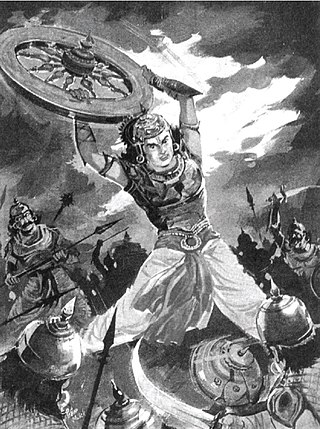
Abhimanyu is a warrior in the Hindu epic Mahabharata. He was the son of Arjuna and Subhadra, the younger sister of Krishna. Abhimanyu is portrayed as a young, strong and talented warrior. He was also one of the few individuals, along with his father, who knew the technique to enter the Chakravyuha, a powerful military formation.

Wayang, also known as wajang, is a traditional form of puppet theatre play originating from the Indonesian island of Java. Wayang refers to the entire dramatic show. Sometimes the leather puppet itself is referred to as wayang. Performances of wayang puppet theatre are accompanied by a gamelan orchestra in Java, and by gender wayang in Bali. The dramatic stories depict mythologies, such as episodes from the Hindu epics the Ramayana and the Mahabharata, as well as local adaptations of cultural legends. Traditionally, a wayang is played out in a ritualized midnight-to-dawn show by a dalang, an artist and spiritual leader; people watch the show from both sides of the screen.

Topeng is a dramatic form of Indonesian dance in which one or more mask-wearing ornately costumed performers interpret traditional narratives concerning fabled kings, heroes, and myths, accompanied by gamelan or other traditional music instruments. Topeng dance is a typical Indonesian dance that can be found in various regions of Indonesia. Topeng dance has the main characteristic that the dancers use masks to cover their faces. The dance will usually be performed by one dancer or a group of dancers.

Wayang wong, also known as wayang orang, is a type of classical Javanese and Balinese dance theatrical performance with themes taken from episodes of the Ramayāna or Mahabharāta. Performances are stylised, reflecting Javanese court culture:
Wayang wong dance drama in the central Javanese Kraton of Yogyakarta represents the epitome of Javanese aesthetic unity. It is total theatre involving dance, drama, music, visual arts, language, and literature. A highly cultured sense of formality permeates every aspect of its presentation.
Hikayat Seri Rama is the Malay literary adaptation of the Hindu Ramayana epic in the form of a hikayat. The main story remains the same as the original Sanskrit version but some aspects of it were slightly modified to a local context such as the spelling and pronunciation of names. Numerous branch stories had also been developed as accretions to or extensions of this epic with the upgrading of minor characters to major ones, or the invention of totally new characters. For example, Malay writers and storytellers have produced variations in which Laksmana (Lakshman) plays a larger role, sometimes becoming more important than Rama the elder prince much like the Lao Phra Lak Phra Lam. Rama, although righteous and virtuous, was perceived to be weak and his character is often moved to the background while the younger Laksmana is admired for his courage and willingness to react decisively.

Wayang golek is one of the traditional Sundanese puppet arts from West Java, Indonesia. In contrast to the wayang art in other areas of Java island that use leather in the production of wayang, wayang golek is a wayang art made of wood. Wayang Golek is very popular in West Java, especially in the Pasundan land area. Today, wayang golek has become an important part of Sundanese culture.
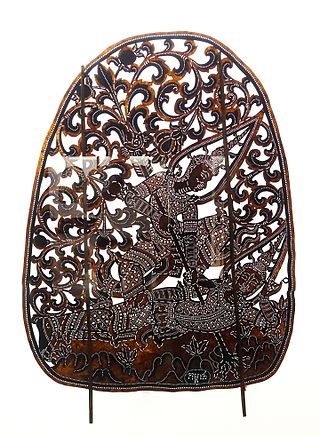
Khmer shadow theatre are forms of shadow play in which leather shadow puppets are used. The two main genres are Sbek Thom, which features the Reamker, and Sbek Toch, which uses smaller puppets and a wide range of stories. Another genre called Sbek Por uses colored leather puppets. The shadow plays of Cambodia are closely related to and also resemble the shadow plays of Thailand, Indonesia (Wayang and Wayang kulit). In Cambodia, the shadow play is called Nang Sbek Thom, or simply as Sbek Thom, Sbek Touch and Sbek Por.

The Panji tales are a cycle of Javanese stories, centred around the legendary prince of the same name from East Java, Indonesia. Along with the Ramayana and Mahabharata, the tales are the basis of various poems, sculpture and painting, dance-drama performances and genres of wayang, especially the one known in East and Central Java as wayang gedhog. Panji tales have been the inspiration of Indonesian traditional dances, most notably the topeng (mask) dances of Cirebon, Central Java and Malang, as well as gambuh dance-drama in Bali. Especially in the environs of Kediri, part of the probable homeland of the tales of Panji, local stories grew and were connected with the obscure legendary figure of Totok Kerot. Panji tales have spread from East Java (Indonesia) to be a fertile source for literature and drama throughout Indochina Peninsula and Malay World as well.
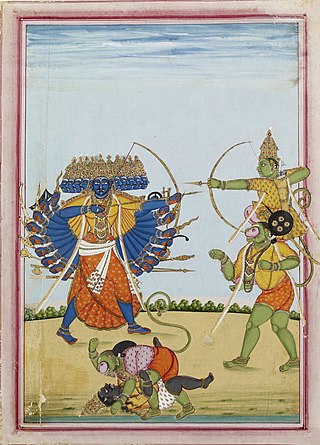
Depending on the methods of counting, as many as three hundred versions of the Indian Hindu epic poem, the Ramayana, are known to exist. The oldest version is generally recognized to be the Sanskrit version attributed to the sage Narada, the Mula Ramayana. Narada passed on the knowledge to Valmiki, who authored Valmiki Ramayana, the present oldest available version of Ramayana.
The Mahabharata is one of the two major Sanskrit epics of ancient India, the other being the Ramayana.
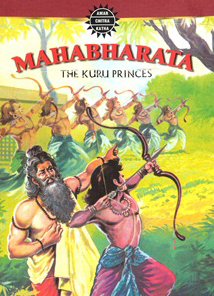
Mahabharata is a comic adaptation of the Indian epic poem Mahabharata. The 42-issue best-selling series by Amar Chitra Katha, Mumbai was illustrated by Dilip Kadam. The team of script writers included Kamala Chandrakant, TMP Nedungadi, Subba Rao, Yagya Sharma, Lopamudra, Mihir Lal Mitra, Sumona Roy, Mohan Swaminathan, Shubha Kandhekar and Margie Sastry.

Petruk is a character in traditional Javanese puppetry, or wayang. He is one of the Punokawan, four comedic figures common in the medium.
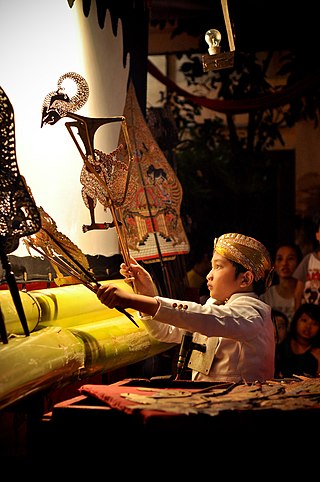
Wayang kulit is a traditional form of shadow puppetry originally found in the cultures of Java and Bali in Indonesia. In a wayang kulit performance, the puppet figures are rear-projected on a taut linen screen with a coconut oil light. The dalang manipulates carved leather figures between the lamp and the screen to bring the shadows to life. The narratives of wayang kulit often have to do with the major theme of good vs. evil.

The Bumilangit Cinematic Universe (BCU) is an Indonesian media franchise and shared universe centered on a series of superhero films produced by Bumilangit Studios based on characters that appear in comic books published by Bumilangit. Volume 1 of the series began with Gundala in 2019 and will conclude with the release of a team-up film Patriot.

PT Bumilangit Entertainment Corpora (Bumilangit) is an Indonesian intellectual property-based entertainment company which has one of the largest comic book character libraries in Asia. Bumilangit maintains a library of more than 1,200 comic characters that have been published over the last sixty years. Currently, Bumilangit is also involved in the production of films, television series, animation, comic publications, licensing, merchandising, and digital business based on those characters.
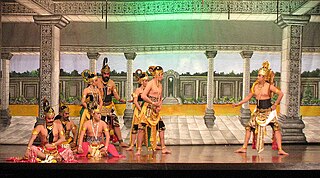
Indonesian theatre is a type of art in the form of drama performances that are staged on a stage, with a distinct Indonesian nuance or background. In general, theatre is an art that emphasizes the performing arts that are displayed in front of a large crowd. In other words, theater is a form of visualisation of a drama that is staged on the stage and watched by the audience. Indonesian theatre includes the performing arts of traditional theater and modern theatre located in the territory of Indonesia. Some examples of Indonesian theater are Arja, Wayang, Wayang wong, Lenong, Ludruk, Janger, Randai and others. Theatre in Indonesia can also be referred to as regional or ethnic theatre, because it originates and develops from 1,300 ethnic cultures in Indonesia.

Wayang beber is an Indonesian wayang performance art whose presentation is manifested in a stretch sheets of paper or cloth with pictures in the stylized wayang accompanied by a narration by a dalang. Wayang beber performances emerged and developed in Java in pre-Islamic times, but continued into the Islamic kingdoms. The stories shown are taken from the Mahabharata and the Ramayana. After Islam became the main religion in Java, more Panji stories were shown. Wayang beber bears a strong resemblance to narrative in the form of pictorial ballads common at annual fairs in medieval and early modern Europe. They too suffered the same fate—nearly extinct, although there are still groups of artists who support wayang beber in places like Surakarta (Solo) in Central Java.

Sri Asih is a 1954 Indonesian lost superhero film directed by Tan Sing Hwat and Turino Djunaedy, and starring Mimi Mariani, Djunaedy, Ali Joego, and Nazar Dollar. This film was the first Indonesian superhero film adapted from comics by R. A. Kosasih.
















